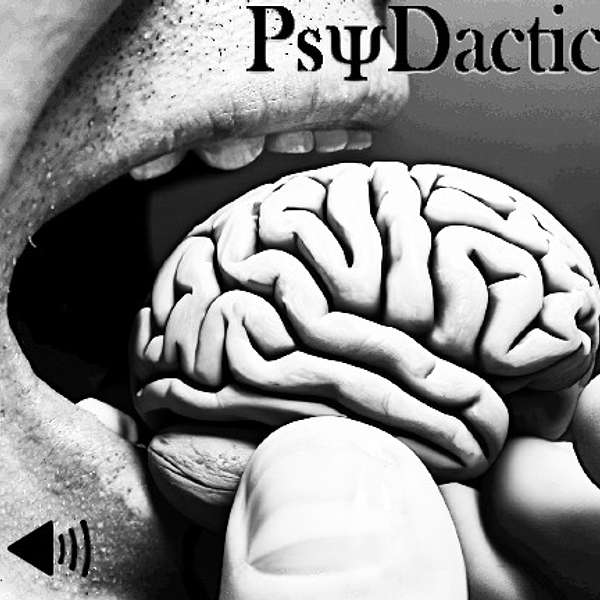
PsyDactic
A resource for psychiatrists and other medical or behavioral health professionals interested in exploring the neuroscientific basis of psychiatric disorders, psychopharmacology, neuromodulation, and other psychiatric interventions, as well as discussions of pseudoscience, Bayesian reasoning, ethics, the history of psychiatry, and human psychology in general.
This podcast is not medical advice. It strives to be science communication. Dr. O'Leary is a skeptical thinker who often questions what we think we know. He hopes to open more conversations about what we don't know we don't know.
Find transcripts with show-notes and references on each episodes dedicated page at psydactic.buzzsprout.com.
You can leave feedback at https://www.psydactic.com.
The visual companions, when available, can be found at https://youtube.com/@PsyDactic.
PsyDactic
Catatonic Signs - Stupor, Mutism, and Negativism
Stupor, Mutism, and Negativism on the surface appear to have some overlapping features. Of all the features of catatonia that non-experts might be able to describe, stupor and mutism are like the ones. They are also the most common signs. A patient is not entirely unconscious, but they don’t move, they stare forward, they don’t talk, and they don’t follow commands.
Please leave feedback at https://www.psydactic.com or send any comments to feedback@psydactic.com.
References and readings (when available) are posted at the end of each episode transcript, located at psydactic.buzzsprout.com. All opinions expressed in this podcast are exclusively those of the person speaking and should not be confused with the opinions of anyone else. We reserve the right to be wrong. Nothing in this podcast should be treated as individual medical advice.
Welcome to PsyDactic Residency Edition. I am Dr. O and this episode is a continuation of our series on Signs of Catatonia. Today, I want to deal with Stupor, Mutism, and Negativism which on the surface appear to have some overlapping features. Of all the features of catatonia that non-experts might be able to describe, stupor and mutism are like the ones. They are also the most common signs. A patient is not entirely unconscious, but they don’t move, they stare forward, they don’t talk, and they don’t follow commands.
But if someone is not doing anything, then they are also not talking, so mutism seems to be just a subset of stupor. Also, if someone is not not doing anything, then they are also not following commands, which qualifies as negativism, AND, since the DSM only requires three of 12 features for a diagnosis, the presence of stupor (because mutism and negativism are likely to be features of stupor) would automatically give a person a diagnosis of catatonia. This does not seem right.
I could not find any good discussions about this issue, so I am going to revert to some logic to help flesh this out. Catatonia is a problem that has a strong relationship to what is going on in your basal ganglia. It may manifest as a vast reduction in behavior, appearing stuck in some kind of behavior, or strange non-goal directed behavior. It may be a glutamate problem, it may be a GABA problem, and it may be related to the fear response mechanism in the brain, like you are stuck in the freeze response. We know agonizing GABA receptors is highly effective in the vast majority of cases. We also know that the vast majority of cases are likely retarded or akinetic, like someone is stuck and just can’t do much of anything. The sign of catatonia that most reflects this state is stupor.
Stupor is defined as a state of being that is short of being unconscious (like when you are comatose, sleeping, sedated, or dead) that is characterized by very little or no interaction with the world around you. Pt’s may stare forward, but they also may have their eyes closed. How can you tell if someone is asleep or not? A physical exam could be helpful. Someone who is asleep should have little or no muscle tone. Someone who is asleep should still withdraw to painful stimuli. In a stuporous patient, you might be able to draw their attention briefly, but it is not sustained. For the most part, they act as if the world around them does not exist or is unimportant to them. They often don’t eat, but they keep on breathing (at least until they develop malignant catatonia when even breathing may stop).
Mutism is by definition a certain type of non-interaction with the world. For mutism to count as a catatonic feature it must be a new onset or a change from recent and it must be distinguished from other known causes of mutism like seizures and strokes. While mutism is almost certainly present if someone is stuporous, being mute does not necessarily mean that you are stuporous. If a patient is mute but not stuporous, then this should be a red flag that there is a reason for their mutism other than catatonia. There are other types of mutism, such as selective mutism, which is often context dependent. Some people go mute when they are experiencing acute distress. There are dissociative episodes (and dissociative is a word I hope to tackle in the future) that may result in mutism. Some patients with autism spectrum disorder describe avolitional intermittent mutism resulting from sensory overload or anxiety. Is this a mild form of catatonia? Benzos can also be helpful with that? It is likely that there are some shared mechanisms in the dysfunction of speech production resulting in catatonic mutism and some of the other kinds of stress or anxiety induced mutism.
Negativism, as I mentioned in the initial episode in this series, is a thorn in my side. It can be defined as not performing a command or doing “the opposite” or what is commanded or requested. These are two very different things. If a patient who is sitting is asked to stand and they remain sitting, then are they doing the opposite or simply not responding. Is that stupor? If you are lucky enough that your patient does the opposite of what you ask, like laying down on the floor if you ask them to stand, then that would be nice. I think the key to negativism is that it appears motiveless to the examiner (like stereotypies are motiveless). Someone who appears able to follow commands but refuses to follow commands because they have a motive not to do so (e.g. avoiding a noxious stimulus) should not be counted as negativism. One test that might be helpful is to attempt to move the patient. Instead of giving even resistance like they would in waxy flexibility, they increase muscle tone in resistance to your efforts. If you try to flex their arm, they initiate resistance when you initiate the movement and then they relax when you relax. Overall their problem is not that their baseline tone is increased, but if you try to examine them, their tone increases in opposition to your efforts.
So let's revisit the at-least-3-features criteria in the DSM and how the overlap of stupor, mutism, and negativism may seem redundant. If a patient is stuporous, then they are not doing things or saying things, though they may be maintaining a posture or have waxy flexibility. Because stupor in a way disqualifies them from other criteria by default, they need a leg up on getting a diagnosis according to the rules set out in the DSM. So to make it easier to qualify stuporous patients for a diagnosis of catatonia and get them treatment. Given that they won’t be able to meet so many of the other criteria because they are not interacting with the world, having some overlapping symptom criteria may not be a bad thing. In some case-series I’ve read about, 97% of patients were stuporous. Also, as a clinician who has a stuporous patient with a high suspicion of catatonia, you may not want to get too picky about counting other symptoms and just give an Ativan challenge to see if you can give them a chance to actually interact with the world again. It’s a reasonable approach in a world with limited time and resources.
I hope to finish out the series on catatonia within the next couple of episodes. Thank you for your patience. I am Dr. O, and this has been an episode of PsyDactic Residency Edition.
Podcasts we love
Check out these other fine podcasts recommended by us, not an algorithm.

Mindhunting: Journeys in Forensic Psychiatry
Dr Michael Schirripa
Brain Science with Ginger Campbell, MD: Neuroscience for Everyone
Ginger Campbell, MD
